MXA RACE TEST: THE REAL TEST OF THE 2020 SUZUKI RM-Z450
HERE IS THE FULL REVIEW OF THE 2020 SUZUKI RM-Z450
Q: FIRST AND FOREMOST, IS THE 2020 SUZUKI RM-Z450 BETTER THAN THE 2019 RM-Z450?
A: You jest. The 2020 Suzuki RM-Z450 is the 2019 RM-Z450.
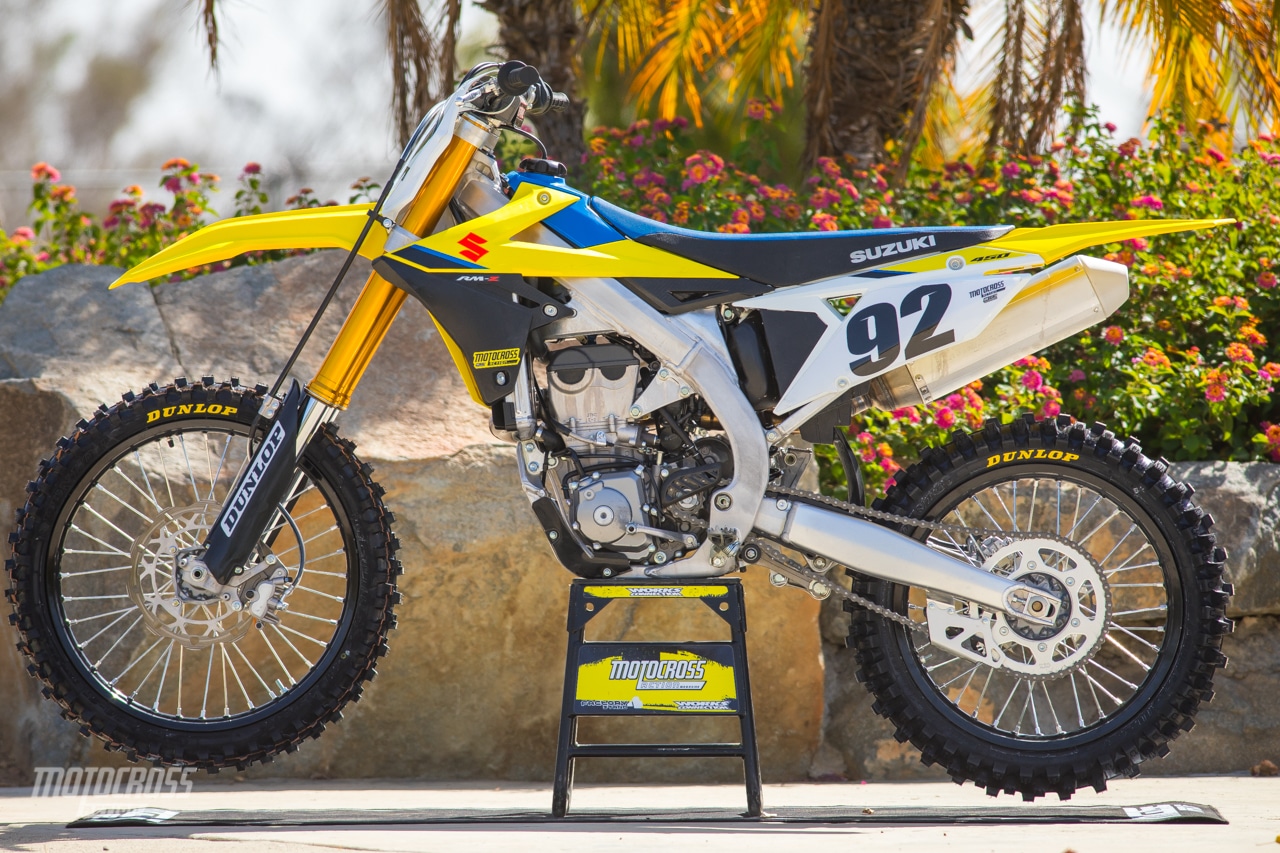 Q: HOW DOES THE 2020 SUZUKI RM-Z450 RUN ON THE TRACK?
Q: HOW DOES THE 2020 SUZUKI RM-Z450 RUN ON THE TRACK?
A: You might find this hard to believe, but most MXA test riders like the 2020 Suzuki RM-Z450 powerband. No, it is not fast by any stretch of the imagination, but the vast majority of motocross speed comes from the right wrist—not the wrist pin. For the average racer, the existing RM-Z450 power is in the perfect place to get the job done. The caveat is that if you are a wannabe AMA Pro or a high-rpm revver, you will not gel with the RM-Z450. Why not? First, an AMA Pro lines up behind the starting gate next to the 39 best starters in the country, and most of them are on 63-horsepower rocket ships. If you have a spare $8000 to put into your RM-Z450’s piston, cams, crank, rod, head, ignition and exhaust, you might get close enough to feel the sting of their roost; but, if you are riding a stock RM-Z450, the roost will hit the ground and stop rolling before you get to it. Second, you can’t rev the Suzuki RM-Z450 because it doesn’t want to be wrung out. Need proof? At 11,000 rpm, the 2020 Suzuki RM-Z450 makes 7-1/2 horsepower less than the 2020 YZ450F. The RM-Z450 makes power up to 8800 rpm, and it’s all downhill from there. Don’t get us wrong; it will rev to 11,000 rpm, but that last 2300 rpm is just noise—not power.
It is not our intention to make the 2020 Suzuki engine appear to be a lost cause, because when short-shifted, kept in the meat of the powerband and used properly, it has a very usable, pleasant and effective 450cc powerband. It is brisk off the bottom and strongest from 7000 to 8700 rpm—and that is where acceleration is generated.
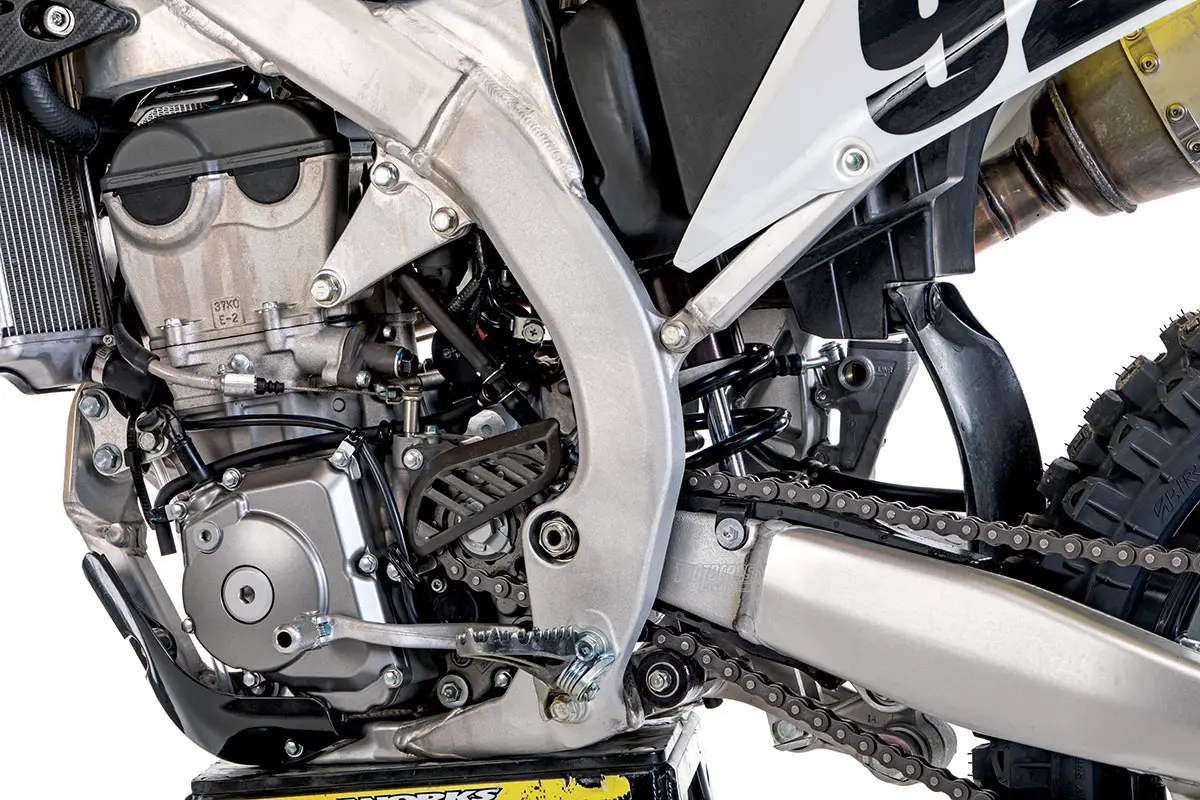
Q: HOW DOES THE 2020 SUZUKI RM-Z450 RUN ON THE DYNO?
A: At peak horsepower, the Suzuki makes 54.39 horsepower at 8800 rpm. It is no secret that 8800 rpm is much lower on the powerband compared to the 2020 Honda CRF450’s 59.74 horsepower at 9600 rpm. But, 8800 rpm is where the RM-Z450’s horsepower is the closest to the other five 450s. After 8800 rpm, the Suzuki is dead in the water. To be successful, you have to race the torque curve more than the horsepower curve. The RM-Z450’s torque is very competitive from 5000 rpm to 8000 rpm. It is in this window that a Suzuki racer can run with the big dogs. Whereas most of the other brands are peaking from 9500 rpm to 10,000 rpm, the Suzuki has already peaked at 8800. Technically, that is the best spot on the curve to peak; however, you have to back that 8800 rpm peak with acceptable high-rpm power. Used properly, that early peak and respectable torque are noteworthy. Stay within the Suzuki RM-Z450’s power profile and you will be in the running. Try to play the high-rpm game and you will be left in the dust.
Q: WHAT ARE THE BEST ATTRIBUTES OF THE 2020 SUZUKI RM-Z450?
A: Living with the 2020 Suzuki RM-Z450 is no different from owning any of the other “Big Six” brands. You have to work with what it gives you, fix what is broken and spend your meager cash to get it where you want it. Here is what we liked.
Powerband. Every test rider loved the powerband because, in the middle of a long moto, when the bumps and jumps are working your body over, the clean bottom and nice midrange are rider friendly.

Tuneablity. The 2020 RM-Z comes with three plug-in maps: stock (white), aggressive (white with two wires sticking out) and mellow (grey). Most test riders preferred the stock plug-in for general racing. The aggressive map perked up the throttle response but was a little lean on the top-end; it’s at its best on Supercross-style tracks.
Cornering. We wouldn’t go so far as to say that the 2020 RM-Z450 is the “best turning” bike anymore. Suzuki’s slavish devotion to the “turn at all costs” philosophy has gone too far. Until you drop the rear, change the race sag and adjust the forks, you will find it to be twitchy and loose. It is best suited to smooth tracks and Supercross jumps.
Ergos. The bodywork is narrower. The bar bend is comfortable, and everything falls at hand easily. Sounds good, but the stinkbug chassis setup takes away from all of the good things, which is why fixing it should be your first priority.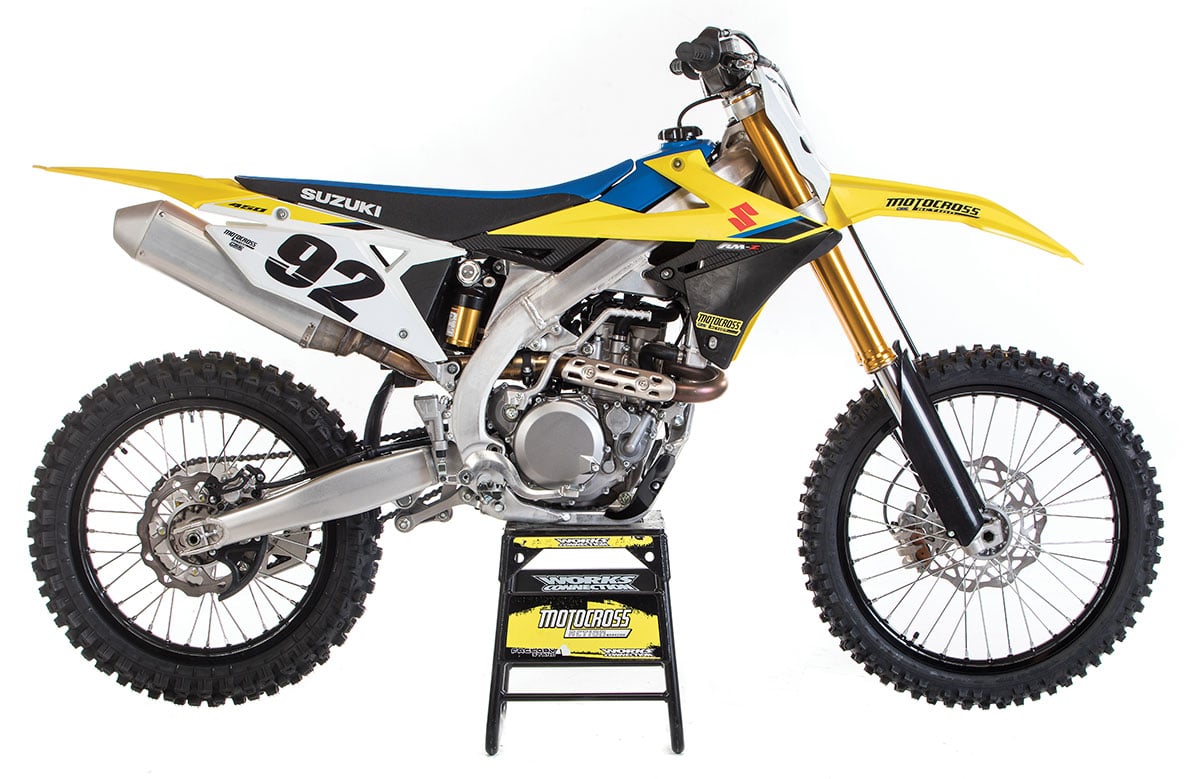 If Suzuki had kept their old frame and spent their R&D money on a new engine, they’d be way ahead of where they are in 2020.
If Suzuki had kept their old frame and spent their R&D money on a new engine, they’d be way ahead of where they are in 2020.
Q: HOW CAN YOU BAND-AID THE TWITCHY CHASSIS?
A: The current RM-Z450 was developed in 2018, and for some reason the Suzuki engineers tried to make it turn even better. Even a snot-nosed kid on a Pee-Wee can tell you that you can’t make anything turn as sharply as an RM-Z450. Sadly, in their effort to maximize its reputation as the best-turning bike made, the Suzuki engineers produced a chassis that was too eager to turn. It went from almost perfect front-end response to oversteering in and castering out. This is not uncommon on brands that are trying to turn like a Suzuki, but it’s odd when you realize that Suzuki was chasing itself. The new frame, used in 2018, 2019 and 2020, doesn’t turn as well as the old one. Yes, it will turn tight, but now it’s on the knife’s edge.
The whole chassis is out of balance. The stinkbug layout transfers too much weight to the front wheel. As strange as it sounds, that is a good thing, not because it is inherently good, but because it can easily be fixed (to a point). MXA’s goal on the 2020 Suzuki RM-Z450 was to get the rear end down and the front end up. This would kick the head angle out to slow down the steering input. An added benefit of a slacker head angle is that the 2020 RM-Z450 doesn’t head shake as much. We set the race sag between 105mm and 110mm and slid the forks down into the triple clamps. How far down? Flush would be about right. You’ll know when and where to stop because the chassis will be flatter to the horizon. The front end won’t feel like it is tucked under your buns, and you won’t be correcting for oversteer with a lot of counter-steer. The onus is on the racer to find his sweet spot. The only clue that we can offer is that it is nowhere near where Suzuki put it.
To help, we ran a longer shock linkage than the stock 135mm link. The longer link lowered the rear of the Suzuki and stiffened the initial part of the shock stroke, which allowed us to have more options in compression, rebound settings, fork height and head angle.
In short, the Suzuki RM-Z450 chassis is too stiff, too tall, too stinkbug and too steep. Yes, you can make it around your local track, and maybe even win your class on a 2020 Suzuki, but you’ll be working a lot harder than the guys you beat.
Q: HOW GOOD ARE THE SHOWA COIL-SPRING FORKS?
A: They are light years better than the 2017 Showa coil spring forks or the SFF-TAC air forks that Showa foisted on the motocross public back in 2016. These forks can easily be fixed. The good thing about the 49mm Showa forks is that they are the same basic forks that the 2020 Kawasaki KX450 and Honda CRF450 run. Given that misery loves company, a fork that comes on three brands will get more attention than a fork that is proprietary to a single brand. That means that your local suspension guru will have enough experience with the 49mm Showas to put it right.
Q: HOW GOOD IS THE SHOWA BFRC REAR SHOCK?
A: It is awesome as long as it never sees a bump. It’s great if you don’t hit chop while leaned over in a corner. It’s incredible when hooked up but a basketball if it lifts off the ground. We’ve never seen a shock on a motocross bike that doesn’t work in the rough stuff. After all, isn’t that the point?
What makes the BFRC shock different from a normal shock? The Showa BFRC shock pumps the shock oil up to the top of the shock to be pushed through the valve stack as opposed to the valve stack being plunged through a pool of oil in the shock body. It is a creative idea based on an Ohlins design. Showa may claim that the BFRC has nothing in common with the Ohlins shock, and that is true, because the Ohlins shock works.
On the track, the shock moves too freely. The loose feeling produces different load characteristics from what motocross racers are used to. Every MXA test rider reported that the 2020 shock felt better than it did in 2019 and that the “wallow” was reduced. And while they were telling us this, they were looking for an aftermarket shock to replace the BFRC.
An experienced suspension shop can revalve the BFRC shock to work well. MXA also tested WP shocks for the RM-Z450 that worked flawlessly, proving that the Suzuki’s rear suspension system can be made to work—without the BFRC shock. Additionally, the 2020 RM-Z250 shock will fit on the RM-Z450.
Q: HOW MUCH DOES THE RM-Z450 WEIGH?
A: At 241 pounds, the RM-Z450 is the heaviest bike on the track. We understand that it is only 3 pounds heavier than the 2020 YZ450F or CRF450, but those bikes don’t have a BFRC shock. In reality, all four Japanese bikes are overweight butterballs that need to lose approximately 15 pounds (the KX450 only weighs 233 pounds, so it could catch up to the 223-pound KTM 450SXF with a 10-pound weight loss). So, why don’t they do it? For the Japanese bikes to lose that much weight, it would cost at least $10 million in R&D, casting, engineering and developmental changes. There is no single place where the RM-Z450 could easily shed that much tonnage, so virtually every part of the bike would have to be re-engineered.
And, since the Suzuki RM-Z450 is the heaviest bike and the only one without electric starting, they would need to trim 23 pounds to add the electric starter, wiring loom and battery to get the RM-Z450 to KTM 450SXF fighting weight. Oh yeah, we forgot, while they are building a whole new bike, they also need to gain 6 horsepower.
Q: WHAT ARE THE REAL AND IMAGINED COSTS?
A: The 2020 Suzuki RM-Z450 is the least expensive 450cc motocross bike on the showroom floors at $8999. That is $1100 cheaper than a Husky FC450, $1000 less than a KTM 450SXF, $400 below a CRF450 and YZ450F, and $300 less than a KX450. We often hear pit pundits claim that they could buy the Suzuki and with the money they save make it as good as the KTM, Honda, Yamaha, Husky or Kawasaki. Okay, let’s go on a spending spree! You could buy an FMF factory 4.1 exhaust system for $900 (closer to $1000 with taxes and shipping). It would not only get you three more horses, it would knock enough weight off the RM-Z that it would weigh the same 238 pounds as the CRF and YZ450F. The kicker? Simple math would tell you that your 2020 RM-Z450 now costs you $600 more than the base price of a YZ450F, KX450 or CRF450. It raises the price of your RM-Z450 to $9999—identical to what a KTM 450SXF sells for. That popular aftermarket pipe purchase may make your RM-Z450 closer in power to its competition, but that is only if they don’t buy the same pipe, gain the same horsepower and lose the same weight as your RM-Z450 did, in which case you spent $9999 to maintain the status quo.
The real-world value of a lower-cost machine is in leaving it alone and racing it as is. If you have to modify it, it won’t be a bargain anymore.
Q: WHAT DID WE HATE?
A: The hate list:
(1) Tire choice. A bike this heavy should be looking to shave ounces off, not add ounces. The Bridgestone Battlecross X30 rear tire weighs almost 2 pounds more than a Dunlop. The front X30 weighs the same as a Dunlop front. We like the Bridgestone X30 front, but prefer the Battlecross X40 rear.
(2) Weight. Invest in an electric bike stand or a gym membership, because you will need it.
(3) Brakes. Suzuki has the weakest front brake of the bikes with 270mm rotors.
(4) Handling. You may not be interested in trying to Band-Aid the 2020 RM-Z450’s handling, but the first time its head shakes down a 40 mph straight, you are going to become a shade-tree engineer.
(5) Kickstart. Not every bike made needs to be outfitted with electric starting, but if we had to pick one bike that needed it more than any other, it would be the Suzuki RM-Z450. Suzuki’s kickstart lever is so high on the cases that short riders, riders with bad knees and weak riders can’t get a full kick.
(6) BNG. The 2020 Suzuki RM-Z450 updates are limited to a blue stripe instead of a red one on the gas tank—that is it.
(7) Clutch. None of the Japanese coil-spring clutches (or Kawasaki’s hydraulic clutch) are as good as the hydraulic clutches on the KTM, Husqvarna and TM. If you can’t afford a Hinson or Rekluse clutch for your RM-Z450, invest in stiffer clutch springs. This isn’t the worst clutch, but it’s only a hair better than the worst one.
Q: WHAT DID WE LIKE?
A: The like list:
(1) Cornering. If you work hard to find the proper fore/aft balance, you can get the Suzuki RM-Z450 back to the good place it was four years ago. The 2018-2020 chassis exhibits some troublesome traits, but intelligent backyard engineering can calm the frame down and bring it back to its glory days.
(2) Power. The 2020 RM-Z450 has a well-placed powerband. It doesn’t make much in the way of peak horsepower, but the power it makes is incredibly usable.
(3) Traction control. The 2020 RM-Z450 features a traction-control system that continually measures throttle opening, engine speed and gear position to adjust the ignition timing and fuel-injector duration to stop wheelspin.
(4) Holeshot Assist. Suzuki’s Holeshot Assist Control (S-HAC) offers three mapping modes for different starting-line setups. We’d be happy with one launch control button that didn’t require us to read the owner’s manual to operate.
Q: WHAT DO WE REALLY THINK?
A: We used to “Fear the Walking Dead,” but that TV show got old after the first 10,000 zombie beheadings. Now we fear for the Suzuki RM-Z450’s future. We think that we could fix the RM-Z450 in an afternoon by lowering the sag, adding a longer shock linkage, switching to the RM-Z250 shock, ordering an aftermarket exhaust system, re-valving the forks and putting stiffer springs in the clutch. We have to wonder what has stopped Suzuki’s engineers from doing the same things.
MXA’S 2020 SUZUKI RM-Z450 SETUP SPECS
This is how we set up our 2020 Suzuki RM-Z450 for racing. We offer it as a guide to help you get your own bike dialed in.
SHOWA COIL-SPRING FORK SETTINGS
Everybody raves about coil-spring forks—largely because of the failures of the Showa SFF-TAC air forks—but prior to its return to coil-spring Showa forks, the last time that Suzuki used coil-spring forks was in 2014. How good were the 2014 RM-Z450 forks? They weren’t very good. We say this so that you get a sense of how far Suzuki has come while backtracking a half decade. For hardcore racing, these are MXA’s recommended 2020 RM-Z450 fork settings (stock settings are in parentheses):
Spring rate: 0.50 N/mm
Compression: 10 clicks out (6 clicks out)
Rebound: 12 clicks out
Fork-leg height: Adjust it for the handling, not the suspension
Notes: We added 10cc of oil to both fork legs to stiffen the forks in the last 4 inches of travel to stop them from bottoming. This gave us more leeway in dialing in the compression. MXA test riders ran the compression from seven to 12 clicks out, depending on rider speed and track conditions.
SHOWA BFRC SHOCK SETTINGS
We loved 2017’s traditional shock absorber, and we wish that we could just swap it over from the old bike to our new one. We can’t. It should be noted that on the BFRC shock, the compression and rebound are adjusted by counting turns on the bleed screws, not by clicks. The BFRC shock does not have a high-speed compression adjuster. Additionally, there is no rebound adjuster under the shock. Both compression and rebound adjusters are mounted on the piggyback and labeled “Ten” for rebound and “Com” for compression. For hardcore racing, these are MXA’s recommended 2020 Suzuki RM-Z450 shock settings (stock settings are in parentheses).
Spring rate: 54 N/mm
Hi-compression: NA
Compression: 1 turn out (1.5 turns out)
Rebound: 1 turn out (3 turns out)
Race sag: 105mm (108mm)
Notes: We hated the high-in-the-rear layout of the 2020 RM-Z450. We tried lowering it with massive race sag changes, because we had no other option, but it made the rear end a little harsher (while helping the chassis). We eventually ran a 1mm-longer shock linkage, which lowered the rear of the bike and stiffened the initial shock damping. We recommend the link.
2020 SUZUKI RM-Z450 VIDEO REVIEW
2020 450 FOUR-STROKE SHOOTOUT VIDEO RESULTS


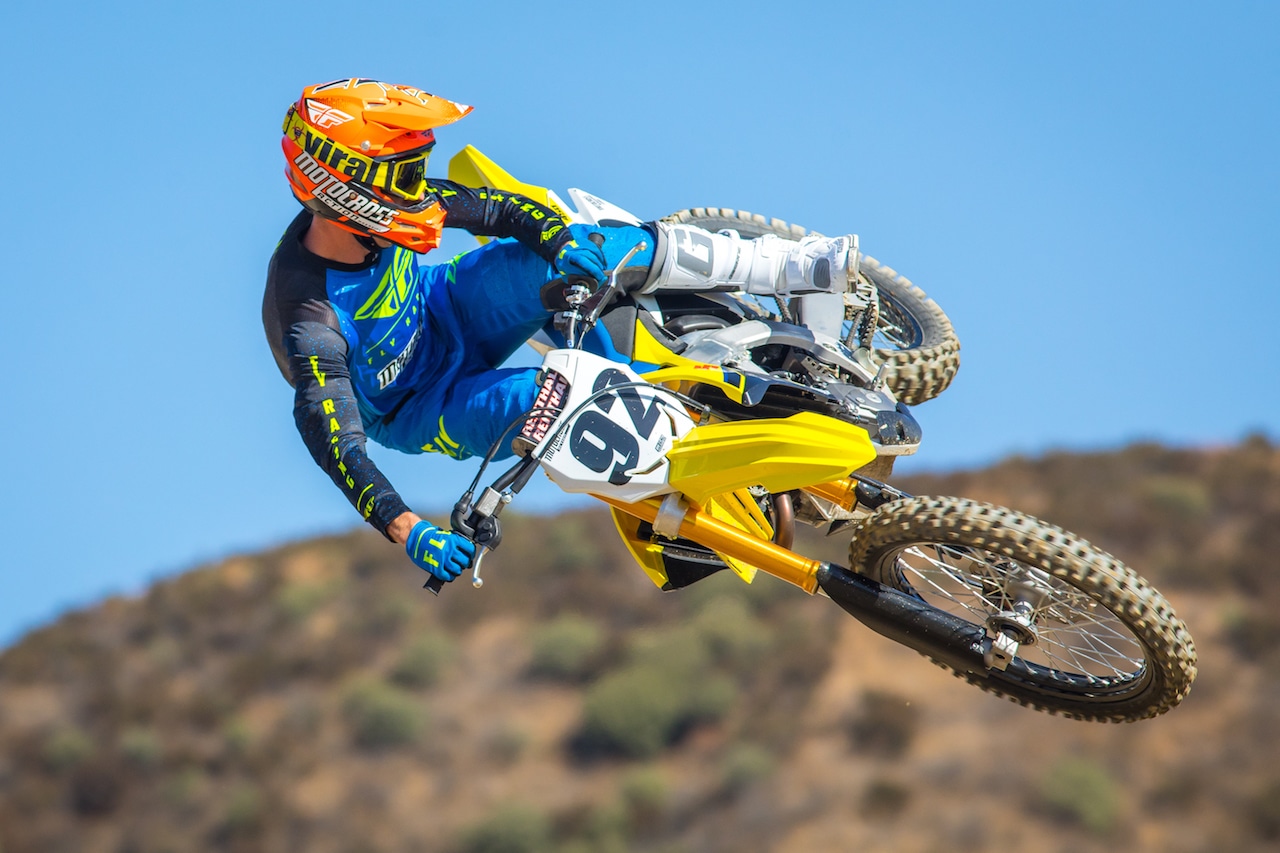
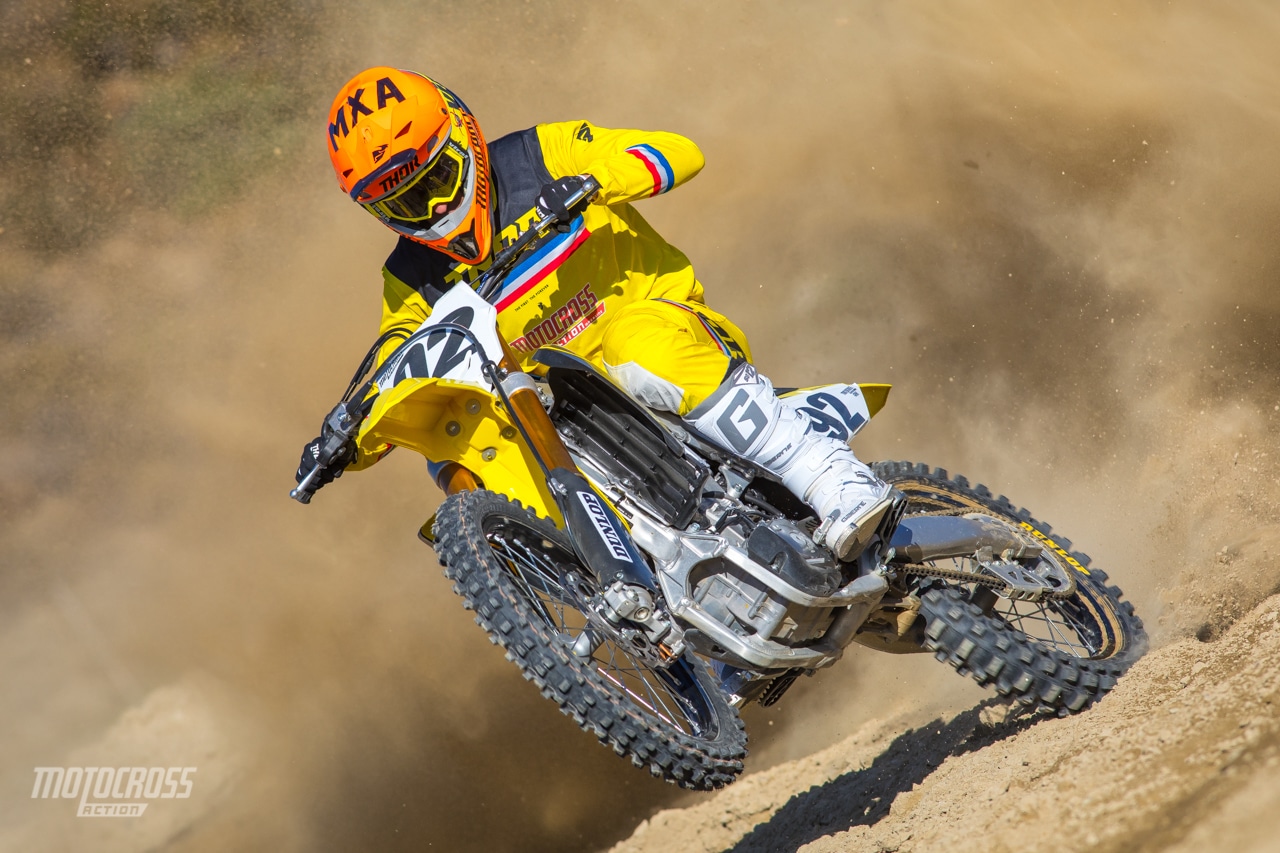

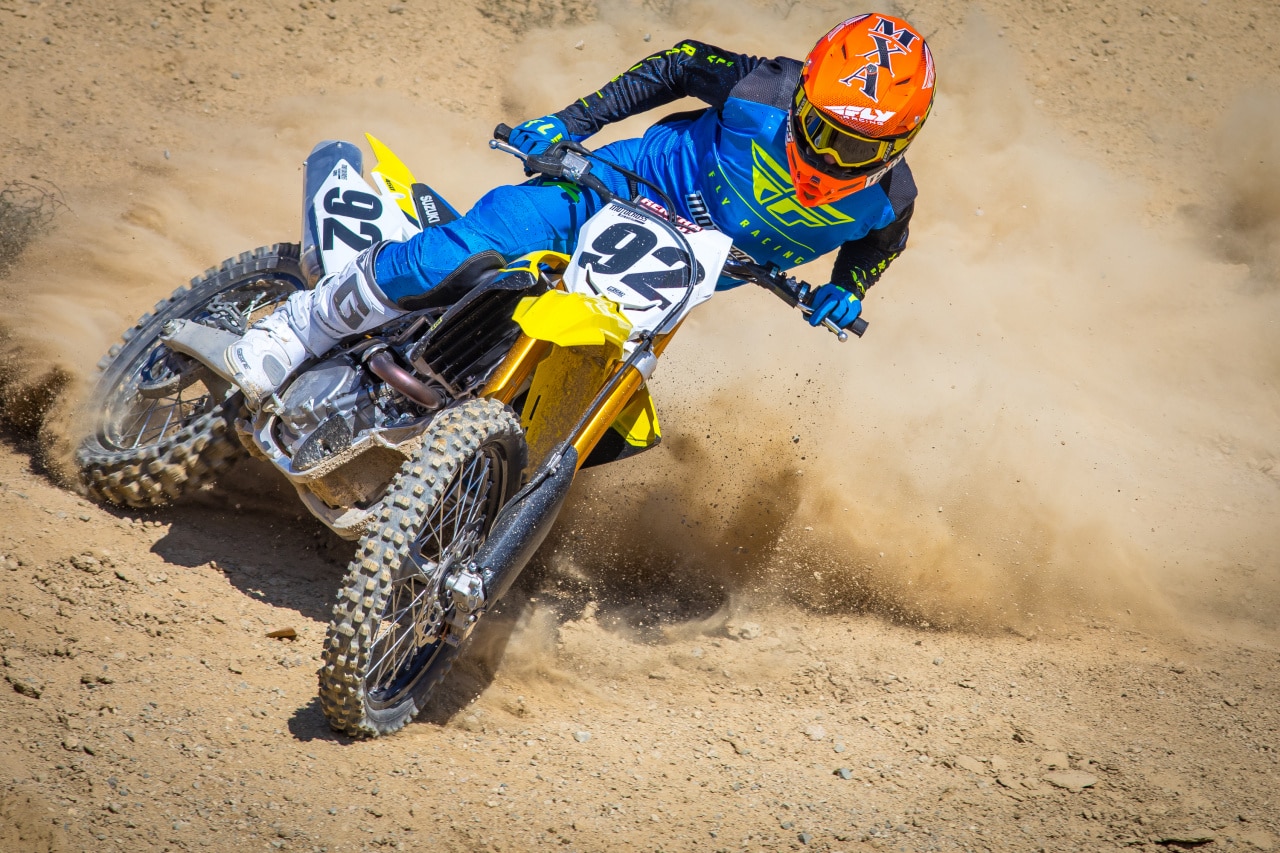

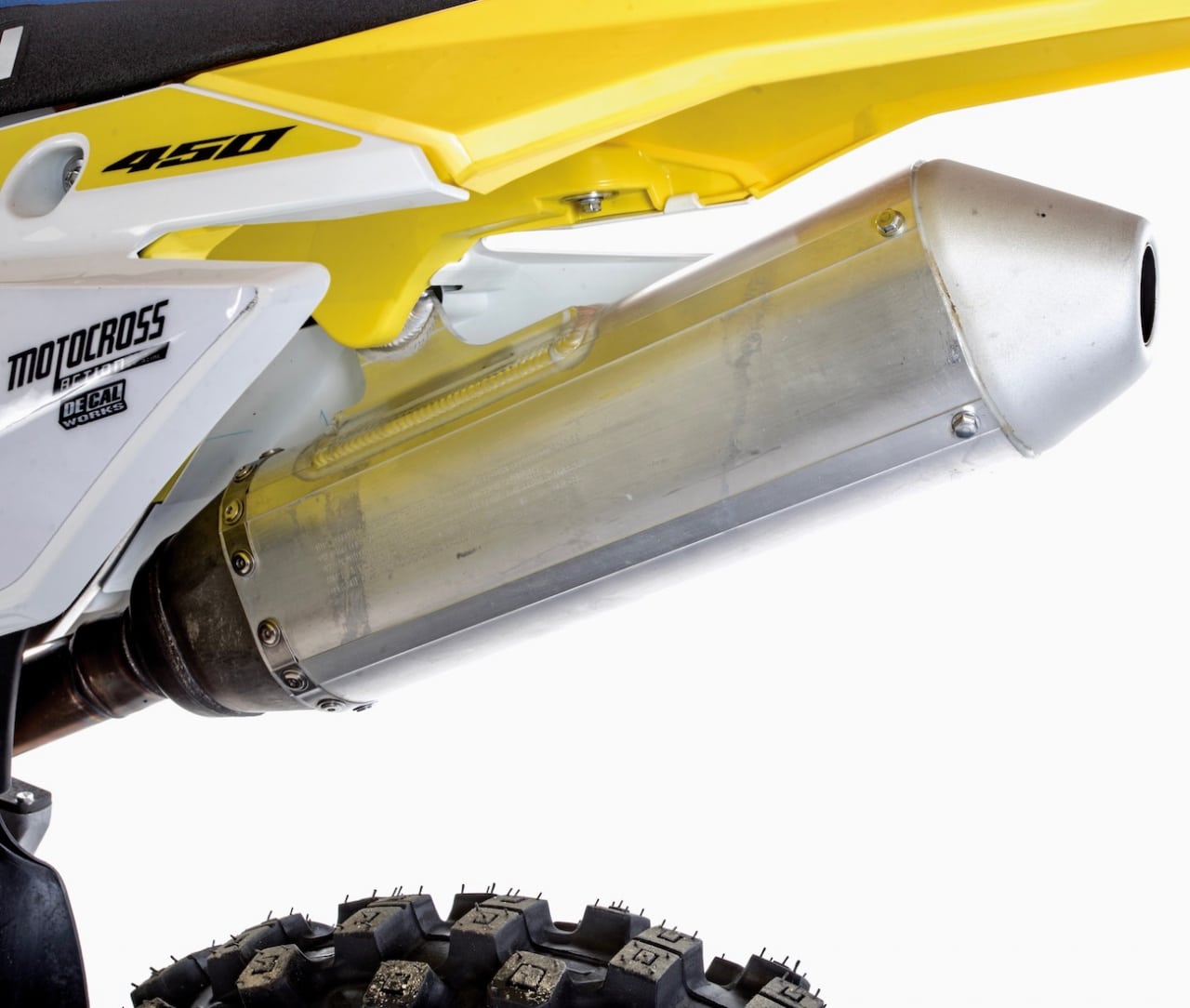
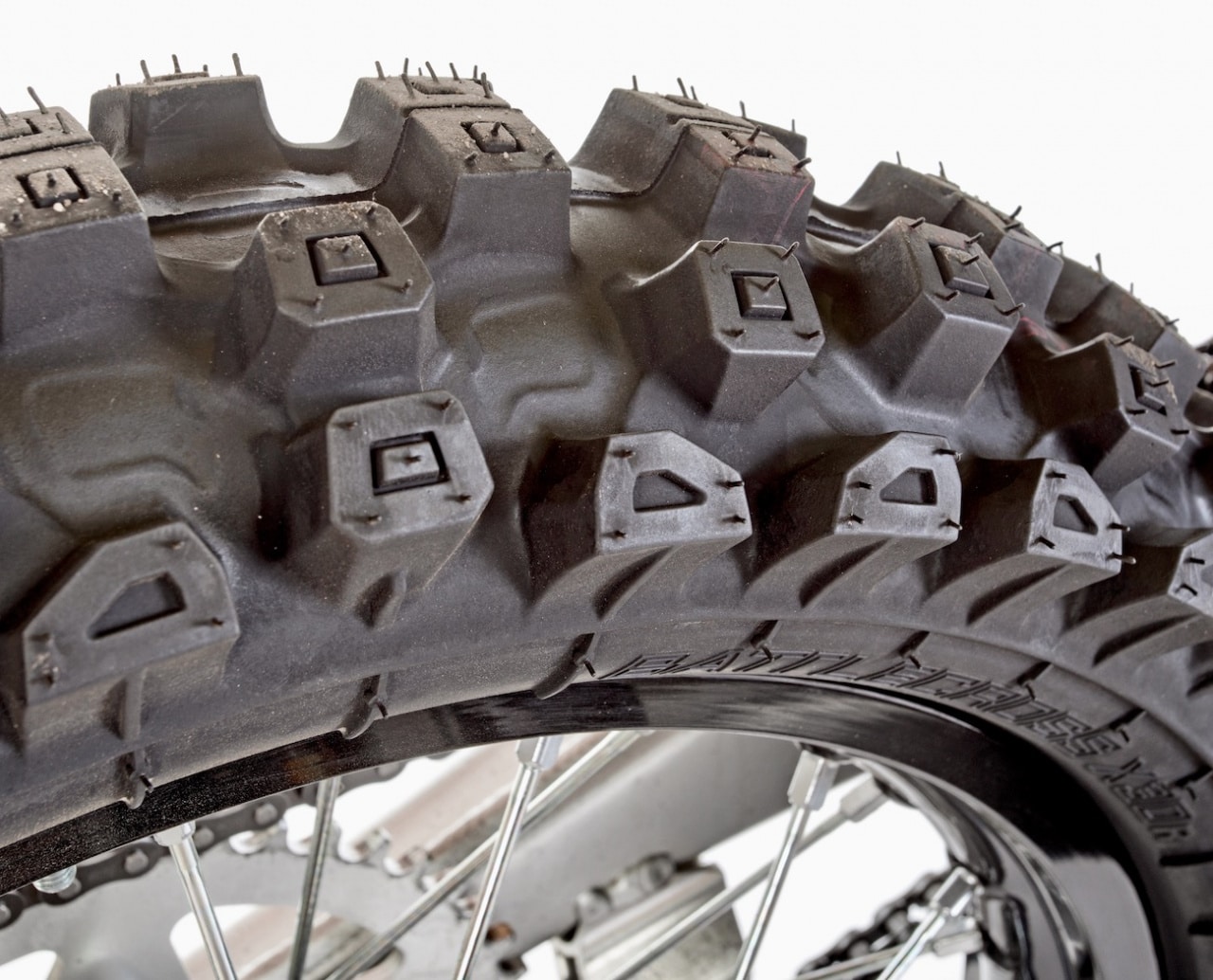
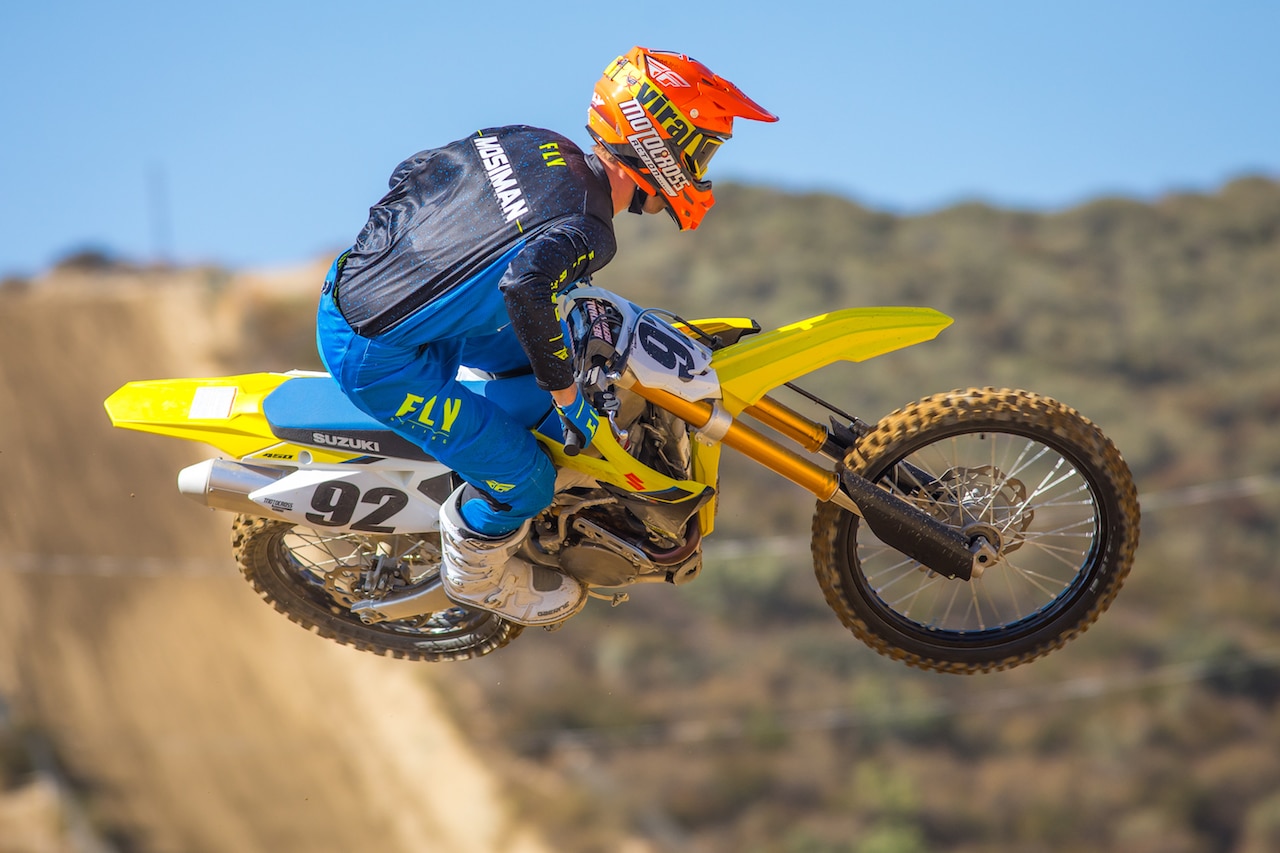
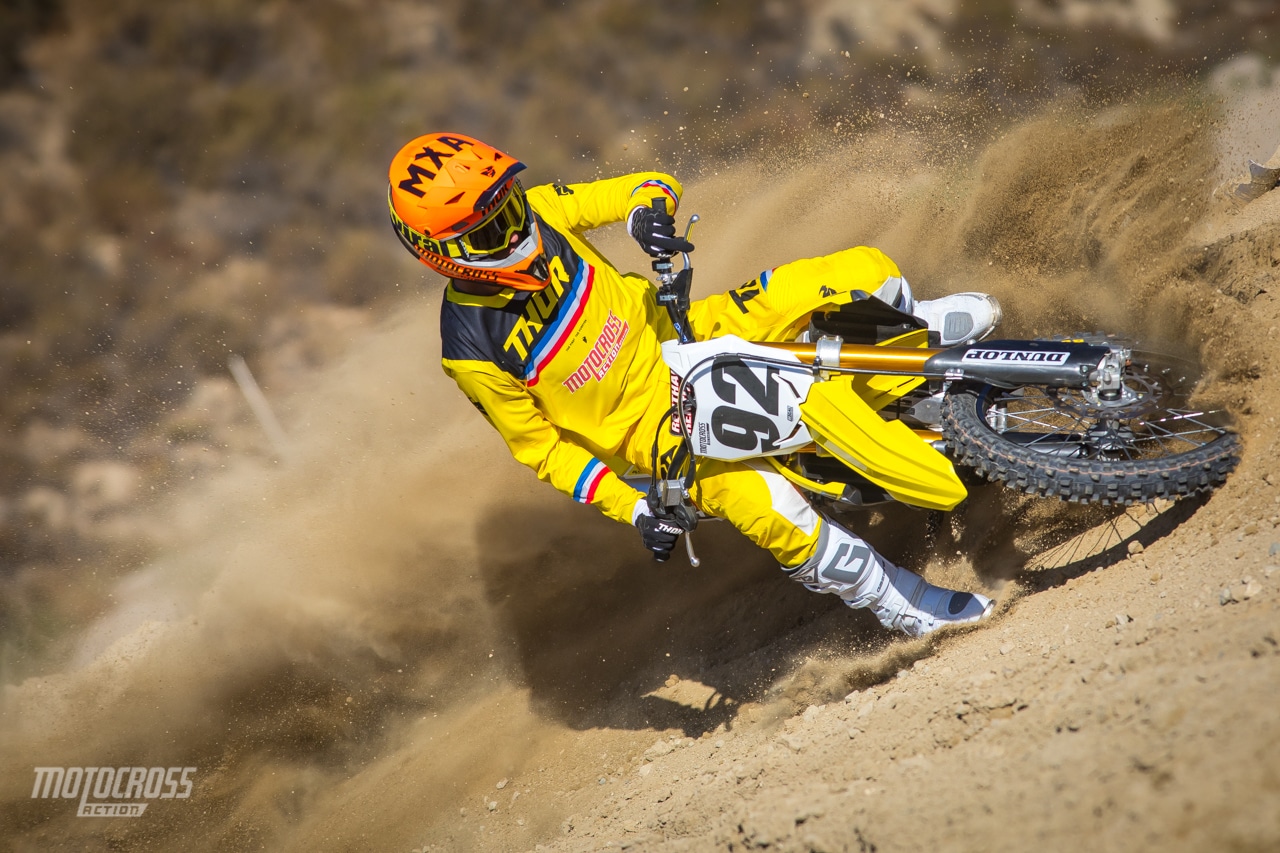
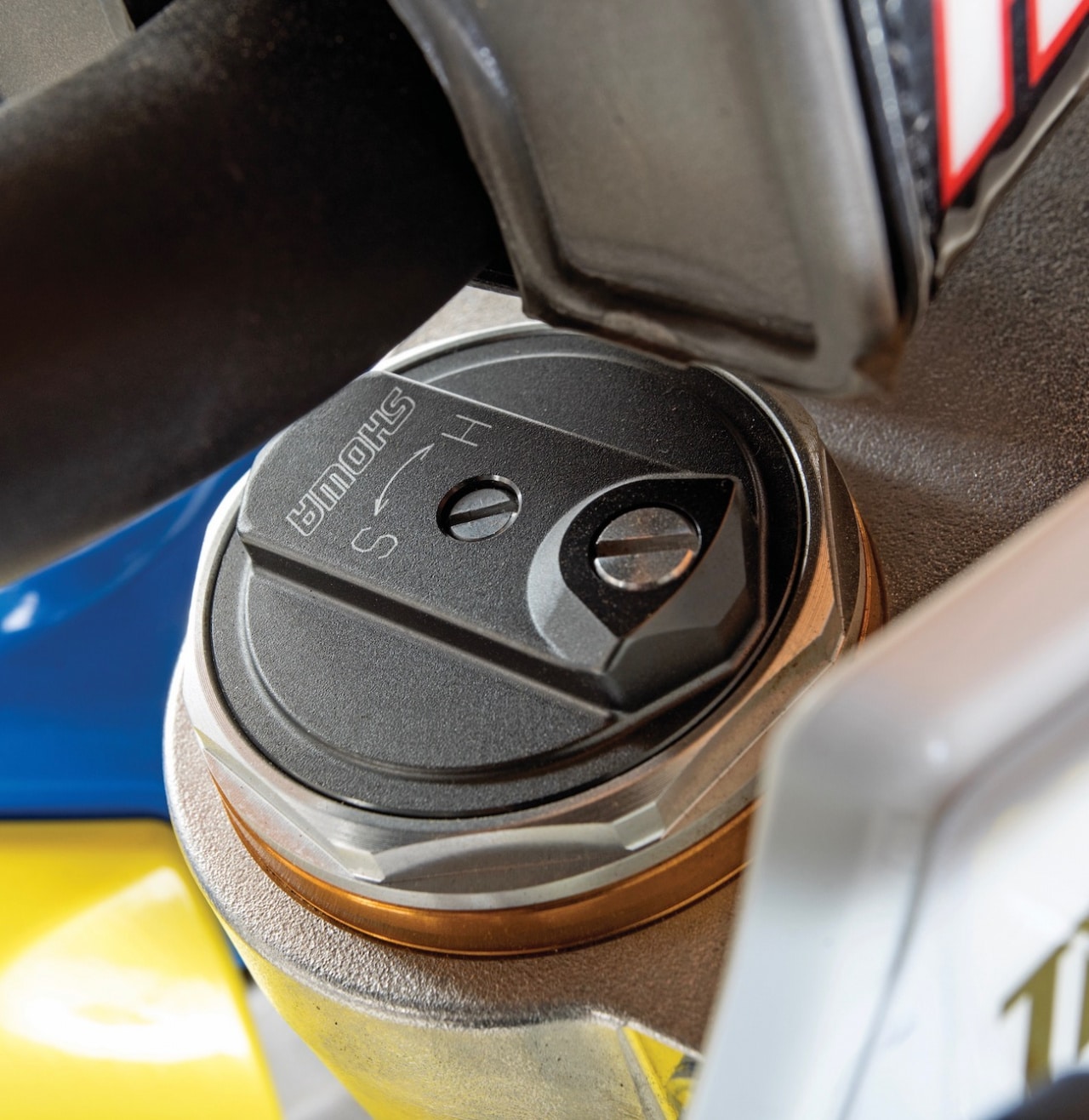
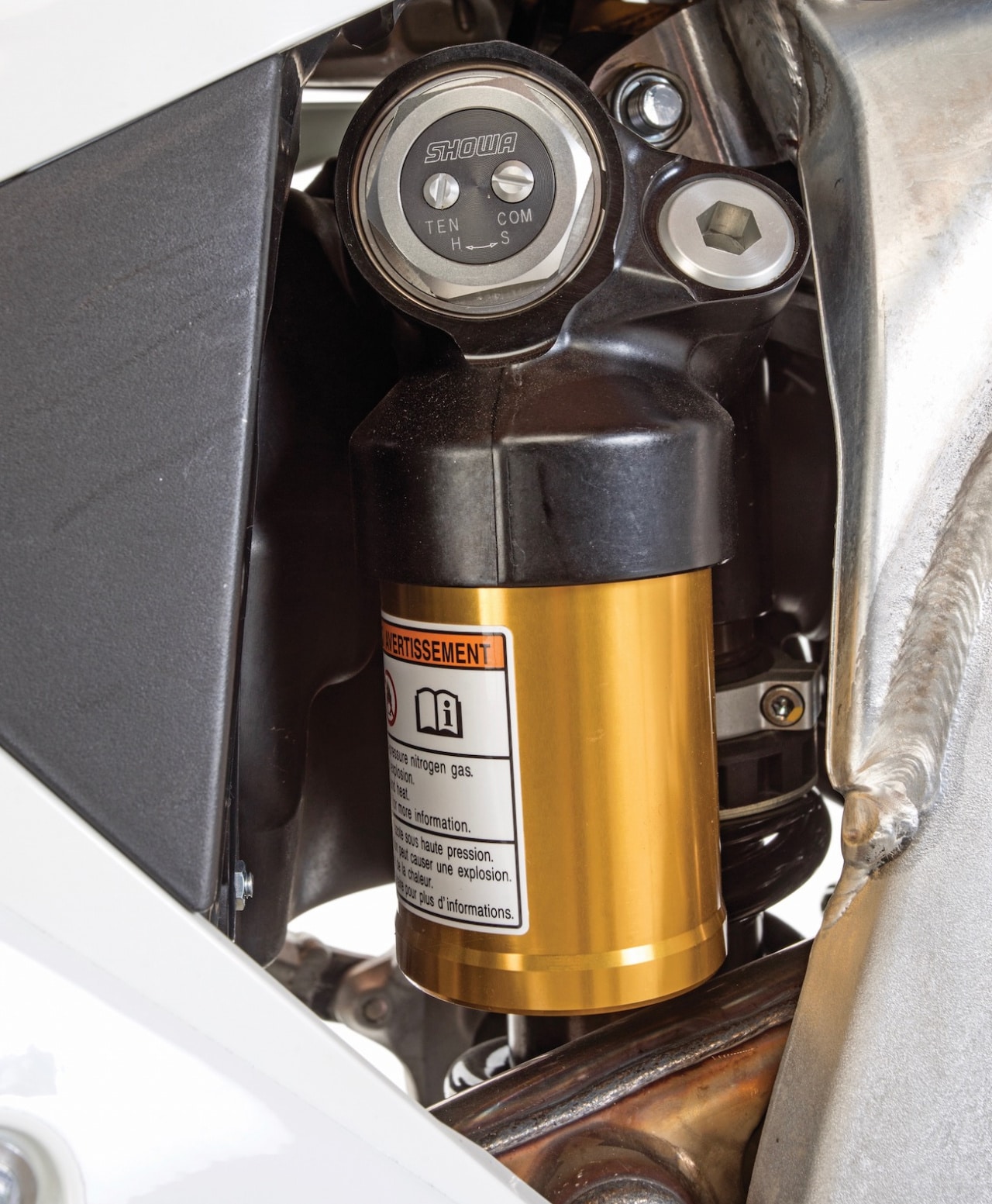



Comments are closed.